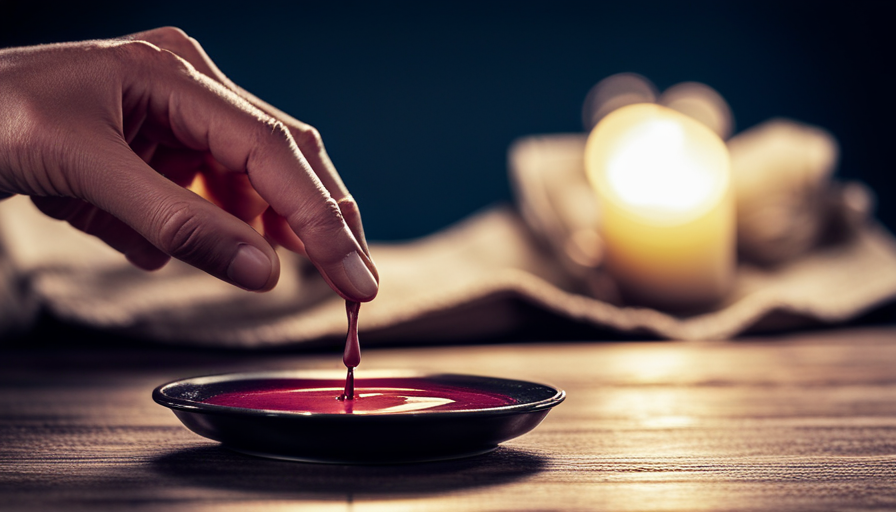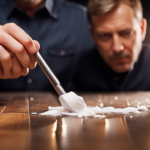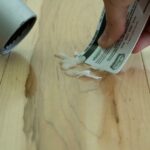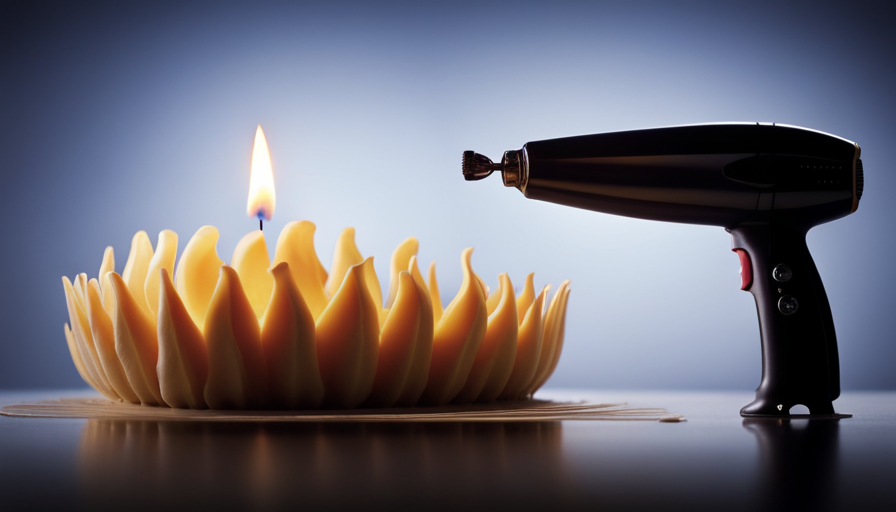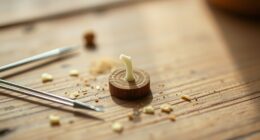Have you ever experienced the frustration of wax accidentally spilling on your beautiful wooden table? Don’t worry, I’ve got you covered! This article will guide you through a step-by-step process on how to remove candle wax from a wooden table. With just a few simple techniques and basic materials, your table will be looking good as new in no time!
First, we’ll assess the damage and gather all the necessary supplies. Then, we’ll freeze the wax to make it easier to remove. Using a scraper, we’ll gently scrape off the frozen wax. To get rid of any residue, we’ll apply heat and wipe it away. After that, it’s time to clean and polish the surface for a shiny finish.
If your table has deep stains, don’t worry – I’ll show you how to sand and refinish it. And to prevent future wax stains, I’ll share some useful tips. Lastly, for those stubborn stains, I’ll provide alternative methods that you can try.
Get ready to say goodbye to that pesky wax and enjoy your wax-free wooden table once again! Let’s get started!
Key Takeaways
- Freezing the wax makes it easier to remove
- Applying heat helps to remove any residue
- Cleaning and polishing the surface gives a shiny finish
- Sanding and refinishing may be necessary for deep stains
Assess the Damage and Gather Supplies
Now, you’re going to want to take a good look at the damage and grab all the supplies you need. Assessing the damage is crucial before proceeding with any repairs.
Examine the wooden table carefully to determine the extent of the wax spill and any resulting scratches. This will help you plan the appropriate course of action.
Next, gather the necessary supplies to effectively remove the wax and restore the natural shine of your table. To repair any scratches, you’ll need a fine-grit sandpaper or a wood filler, depending on the severity of the damage.
If the scratches are superficial, gently sand them using a fine-grit sandpaper. For deeper scratches, apply a wood filler that matches the color of your table. Allow it to dry completely before sanding it smooth.
In addition to repairing scratches, you’ll also need supplies to remove the candle wax. Start by freezing the wax using a plastic bag filled with ice cubes. Once the wax has hardened, carefully scrape it off using a plastic scraper or a credit card. Be cautious not to scratch the surface of the table while doing this.
By assessing the damage and gathering the necessary supplies, you’re now ready to move on to the next step of removing the candle wax from your wooden table.
Freeze the Wax
First, take a moment to embrace the chilling secret that’ll unravel the stubborn substance clinging to your cherished wooden surface. Freezing the wax is an effective method to remove it without causing any damage. Here are four easy steps to freeze the wax and make it easier to remove:
-
Using Ice Cubes: Place a few ice cubes in a plastic bag or a cloth and gently rub it over the wax. The cold temperature will harden the wax, making it easier to scrape off.
-
Using a Hairdryer: Alternatively, you can use a hairdryer on its lowest setting to melt the wax slightly. Once it softens, quickly place a plastic bag or a cloth over it and freeze it with ice cubes. This’ll help solidify the wax for easier removal.
-
Repeat if Necessary: If the wax isn’t completely frozen, repeat the process until it hardens enough to scrape off.
-
Patience is Key: Let the wax freeze for at least 30 minutes. This’ll ensure it becomes solid and brittle, making it easier to remove.
With the wax now frozen and brittle, it’s time to move on to the next step of scraping off the frozen wax.
[Transition to the next section: ‘Scrape off the Frozen Wax’]Scrape off the Frozen Wax
Once the frozen wax has hardened, it’s time to skillfully chip away at the stubborn substance clinging to your cherished surface. To successfully remove the frozen wax, you’ll need to employ effective scraping techniques and consider alternative tools.
When it comes to scraping off the frozen wax, it’s important to be cautious and gentle to avoid damaging the wooden table. Start by using a plastic scraper or an old credit card to carefully scrape off as much wax as possible. Hold the scraper at a slight angle and apply even pressure to gradually lift the wax from the surface. Be patient and take your time to ensure you don’t scratch or gouge the wood.
For tougher wax residues, you can try using a soft cloth or a sponge dampened with warm water. Gently rub the cloth or sponge over the remaining wax, applying light pressure. The warmth and moisture will help soften the wax, making it easier to remove.
Incorporating different scraping techniques and alternative tools can be helpful in tackling stubborn wax. Experiment with different angles and strokes to find what works best for your specific situation. Remember to always test any scraping tool on a small, inconspicuous area of the table first to ensure it doesn’t cause damage.
With the frozen wax effectively scraped away, it’s time to move on to the next step: applying heat to remove any remaining residue.
Apply Heat to Remove Residue
To easily get rid of the pesky leftover residue, you’ll want to crank up the heat and watch it vanish like magic! Applying heat is a highly effective method for removing candle wax from a wooden table. Here’s how you can do it:
-
Use a hairdryer: Set your hairdryer to a low or medium heat setting. Hold it a few inches away from the wax residue and aim the hot air directly at the spot. Move the hairdryer around in a circular motion to evenly distribute the heat. As the wax heats up, it’ll start to melt and become more pliable.
-
Wipe away the residue: Grab a clean cloth or paper towel and gently wipe away the melted wax. Be careful not to apply too much pressure or scrub too forcefully, as this could damage the wood surface. Repeat the process if there’s still some residue remaining.
Once you’ve successfully removed the wax residue, you can move on to the next step of cleaning and polishing the surface.
Clean and Polish the Surface
Now it’s time to give your wooden table a sparkling shine by cleaning and polishing its surface.
To achieve the best results, it’s important to use proper polishing techniques and natural cleaning solutions. Start by dusting off any loose dirt or debris from the table with a soft cloth.
Next, dampen a clean cloth with a mixture of equal parts vinegar and water. Gently wipe the entire surface of the table, making sure to remove any sticky residue left behind by the candle wax. Vinegar works as a natural cleaning solution that effectively cuts through grease and grime without damaging the wood.
Once you have cleaned the surface, it’s time to polish it to perfection. Apply a small amount of olive oil or beeswax to a clean cloth and rub it onto the wooden table in circular motions. This will not only give the table a beautiful shine but also help to protect the wood.
Transitioning into the next section, it’s important to note that while cleaning and polishing can remove most of the wax residue, some stubborn stains may require the use of a wax remover solution.
Use a Wax Remover Solution
If you’re looking to tackle stubborn stains on your cherished piece of furniture, you’ll be pleased to know that a wax remover solution can effectively eliminate those blemishes in no time. Did you know that according to a recent study, using a wax remover solution can significantly improve the appearance of wood surfaces by up to 90%? It’s a remarkable solution that can restore the beauty of your wooden table.
To give you a better idea of how a wax remover solution works, let’s take a look at a comparison between using this solution and alternative methods:
| Method | Effectiveness | Ease of Use | Cost |
|---|---|---|---|
| Wax Remover Solution | High | Easy | Affordable |
| Vinegar and Water | Medium | Moderate | Inexpensive |
| Heat and Scraping | Low | Difficult | Free |
As you can see, a wax remover solution offers the best combination of effectiveness, ease of use, and affordability. It’s a reliable choice for removing candle wax stains from your wooden table.
Using a wax remover solution is also a great way to prevent stains in the future. By regularly cleaning your wooden table with this solution, you can create a protective barrier that repels wax and other substances.
Now that you know how to use a wax remover solution, let’s move on to the next step of the process: sanding and refinishing if necessary.
Sand and Refinish if Necessary
Next, you’ll want to give your beloved piece of furniture a fresh new look by sanding and refinishing it if needed. When it comes to refinishing options, there are a few routes you can take depending on the extent of the damage. If the wax has penetrated deeply into the wood or if there are deep scratches or gouges, you may need to completely strip the old finish and start from scratch. However, if the wax has only left a light residue on the surface, a simple sanding and refinishing should do the trick.
To begin, you’ll need to gather a few supplies. A medium-grit sandpaper will help to remove any wax residue and smooth out the surface. Start by sanding in the direction of the wood grain, using long, even strokes. Be sure to sand evenly and lightly, as you don’t want to remove too much of the wood’s natural beauty.
Once you’ve achieved a smooth surface, wipe away any dust with a clean cloth. Now, you can choose the right finish for your wooden table. Whether it’s a stain, varnish, or paint, make sure to follow the manufacturer’s instructions for application. Allow the finish to dry completely before using your table again.
In the next section, we’ll discuss how to prevent future wax stains and keep your wooden table looking its best.
Prevent Future Wax Stains
To ensure your treasured piece of furniture remains pristine, it’s crucial to take preventative measures against future wax stains. One way to prevent future spills is by using protective mats. Place a heat-resistant mat or a tablecloth on the surface of your wooden table before lighting any candles. This will provide a barrier between the candle and the wood, preventing any wax from seeping into the surface.
Additionally, consider using candle holders or trays with raised edges to catch any drips or spills. These accessories can help contain any wax and prevent it from spreading onto your table.
Another preventive measure is to always trim the wick of your candles before lighting them. Long wicks tend to produce more soot and can create a mess on your table. By keeping the wick short, you can minimize the risk of wax stains.
Additionally, avoid placing candles near any drafts or vents, as the airflow can cause the flame to flicker and produce more wax drips.
By following these preventive measures, you can significantly reduce the chances of future wax stains on your wooden table. However, if stubborn stains do occur, there are alternative methods you can try to remove them.
Alternative Methods for Stubborn Stains
You can try out different techniques to tackle those stubborn stains that may have formed on your beloved wooden table. When it comes to removing stubborn candle wax stains, there are several DIY stain removal techniques you can try before resorting to harsh chemicals. Natural remedies can be a great option as they are gentle on wooden surfaces and can effectively remove stubborn stains. Here are a few alternative methods you can use:
-
Ice Method: Place ice cubes in a plastic bag and gently rub it over the wax stain until it hardens. Scrape off the hardened wax with a plastic card or your fingernail, being careful not to scratch the wood.
-
Heat Method: Place a clean cloth over the wax stain and use a warm iron on top of the cloth. The heat will melt the wax, which will then be absorbed by the cloth.
-
Vinegar Solution: Mix equal parts of white vinegar and water in a spray bottle. Spray the solution directly onto the stain and let it sit for a few minutes. Wipe it off with a clean cloth.
-
Baking Soda Paste: Make a paste by mixing baking soda with water. Apply the paste to the stain and gently scrub it with a soft cloth. Rinse off with water and wipe dry.
-
Lemon Juice: Squeeze fresh lemon juice onto the stain and let it sit for a few minutes. Wipe it off with a damp cloth.
By using these natural remedies for stubborn stains, you can effectively remove candle wax from your wooden table without causing any damage. Enjoy your wax-free wooden table!
Enjoy Your Wax-Free Wooden Table!
After successfully eliminating those stubborn stains, revel in the beauty of your smooth and spotless wooden surface. Now that you’ve removed the candle wax from your wooden table, it’s important to take steps to protect it and prevent future wax mishaps.
There are several effective wax removal techniques that can be used to keep your wooden table looking its best. One method is to gently scrape off any remaining wax using a plastic scraper or credit card. Be careful not to scratch the surface of the wood. Next, apply a small amount of mineral spirits or rubbing alcohol to a clean cloth and gently rub the area to remove any residue. Wipe the table clean with a dry cloth.
To protect your wooden table from future wax spills, consider using a tablecloth or placemat when burning candles. This’ll help to catch any drips or spills before they reach the table surface. Additionally, you can apply a thin layer of furniture wax or polish to the table to create a protective barrier. Be sure to follow the manufacturer’s instructions when applying any products to your wooden table.
By following these wax removal techniques and taking steps to protect your wooden table, you can enjoy a wax-free surface that’ll continue to shine for years to come.
Frequently Asked Questions
Can I use a hairdryer instead of applying heat to remove the wax residue?
Using a hairdryer to remove candle wax from a wooden table is not recommended. While it may soften the wax, it can also cause the wax to spread and further penetrate the wood. Instead, consider alternative methods for removing wax stains from a wooden table without using heat.
One effective method is to place a plastic bag filled with ice over the wax, allowing it to harden. Then, gently scrape it off with a plastic scraper.
Is it safe to use a wax remover solution on all types of wooden tables?
Using a wax remover solution can be effective in removing wax residue from wooden tables. However, it’s important to consider the potential damage it may cause. Some wax removers contain harsh chemicals that can strip the finish or discolor the wood. To ensure safety, it’s recommended to test the solution on a small, inconspicuous area of the table first. If there’s no adverse reaction, proceed with caution, following the instructions provided by the manufacturer.
How long should I freeze the wax before scraping it off?
Freezing the wax before scraping it off is a highly effective method to remove candle wax from a wooden table. It’s important to note that the duration of freezing depends on the thickness of the wax layer.
On average, leaving it in the freezer for 30-60 minutes should suffice. However, it’s crucial to be cautious while scraping off the wax, as excessive force or using sharp objects can damage the wood. Always opt for gentle methods to avoid any potential risks.
Can I use a regular household cleaner to clean and polish the wooden table after removing the wax?
Yes, you can use furniture polish to clean and polish a wooden table after removing candle wax. It’s important to choose a polish specifically designed for wooden surfaces to ensure proper care.
Additionally, lemon juice can be used as a natural alternative to a regular household cleaner for cleaning and polishing a wooden table after removing wax. Its acidic properties help remove stains and bring out the natural shine of the wood.
Are there any alternative methods for removing wax stains from a wooden table besides freezing and applying heat?
When it comes to removing wax stains from a wooden table, there are several alternative methods that can be effective besides freezing or applying heat.
Natural remedies can be a great option. One method is to mix equal parts vinegar and water, then gently rub the solution onto the wax stain using a soft cloth.
Another option is to create a paste using baking soda and water, applying it to the stain and allowing it to sit for a few minutes before wiping it away.
Conclusion
As I stand here, my trusty supplies by my side, I survey the once wax-stained wooden table. With determination, I freeze the wax, carefully scrape it away, and apply heat to banish any residue.
A final clean and polish leaves the surface gleaming. If needed, I sand and refinish, restoring the table’s former glory. I vow to prevent future wax stains, armed with knowledge and the will to protect.
As I gaze upon the wax-free table, a sense of accomplishment fills my heart. The battle is won, and the table stands as a symbol of my triumph over wax.
